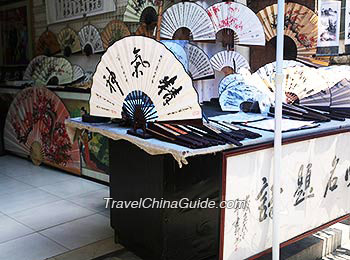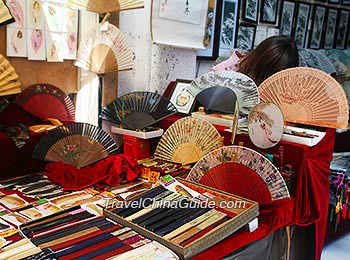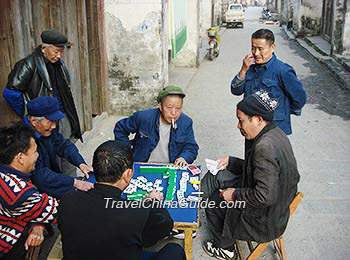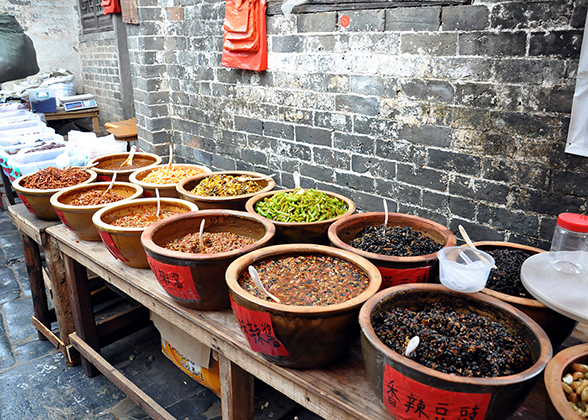Fuli Ancient Town is 8 kilometers (4.9 miles) away from Yangshuo in Guilin and has a history of over 1,000 years. The town, with gorgeous natural landscapes, stands beside
Li River where Feifeng Hill, Parrot Hill and Horse Hill rise on three sides. This beautiful scenery was the perfect backdrop for the movie Liu Sanjie filmed here. The cultural architectures, products and customs here are also both attractive and interesting.
What to See in Fuli?
Fuli Ancient Town’s houses were constructed during the late
Qing Dynasty (1644 - 1911). The clay sculptures on the roofs depict vivid flowers and birds. The town once had three streets, nine wells, eighteen lanes, three palaces, three temples and three pavilions. Some of the old buildings are preserved and three pavilions remain in Fuli Ancient Town.
The pavilions are Daguang Pavilion, Kuixing Pavilion and Jielong Bridge Pavilion. The octagonal Daguang Pavilion of stone column structure stands on the Fuli Dock. The stele in the pavilion is inscribed with poems in praise of the beauty of the landscape and Fuli Ancient Town at night. To the north of the pavilion, you can see Kuixing Pavilion, a high arch architecture constructed with large stone bricks. Jielong Bridge Pavilion is constructed on a bridge with a 3-meter (9 feet) high stone shaped like a dragon head.
There are three stones 30 meters (32 yards) away from Daguang Pavilion, called Sangu Stones. Nobody knows when these stones were brought to Fuli Ancient Town or where they came from. Knock on the stones and you hear a strong and solid sound like a great bell. Near the stones are tens of Banyan trees.
Fuli - Home Town of Painted Fans in China
Fuli Ancient Town is known also as Chinese Painted Fan Town as exquisitely painted fans are created here. When you walk along the town’s Ancient Street, you will find a great variety of painted fans for sale. They are handcrafted from mao bamboo from beside Li River and local tissue paper. Open a fan, and you will see a beautiful and colorful painted Guilin landscape or a poem extolling the wonders of Yangshuo.
 | | Fans Drawn with Chinese Calligraphy | |  | | A Shop Selling Painted Fans | |
Nuo Culture and Mazu Culture in Fuli
There are different cultures co-existing in Fuli Ancient Town because almost half of local people are immigrants from Guangdong, Fujian, Jiangxi and Hunan Provinces. Many observe the ancient Nuo Culture originating from primitive tribes. The music and dance of Nuo Culture are performed to expel evil spirits. Another important culture in the town is Mazu Culture. Mazu is the Goddess of the Sea revered by people from Guangdong and Fujian Provinces. Tianhou Palace in the town is dedicated to the memory of Mazu. The windows, halls and beams of the palace are decorated with carved dragons and phoenixes. Upon entering the palace, you will see two consecrated statues of Bodhisattva. One is Mazu, also called Popo while the other is called Gonggong symbolizing benevolence and loyalty.
Cultural Fair on Lunar May 8
On every lunar May 8, a festival is held in Fuli Ancient Town to celebrate the births of the two Gods venerated in Tianhou Palace. The statues of the Gods are placed in a red sedan and carried from Tianhou Palace to the town’s Culture Square. In the square, the parade of colorful flags and the sedan is followed by different groups of performers such as Yangko group, rowboat dance group and Dragon and Lion Dance group. The drum music played throughout the performance is very exciting and interesting. These art performances, from different areas of China, gather here to celebrate and promote the peoples’ pursuit of happiness.
- Last updated on Nov. 07, 2024 by Zoey Gong -



